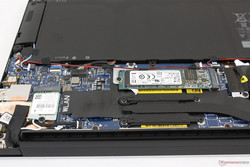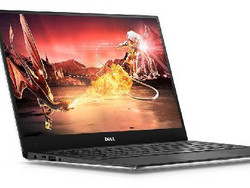Dell XPS 13 i7-8550U (XPS Series) Specs
Processor
Intel Core i7-8550U (Intel Core i7)
Graphics adapter
Intel UHD Graphics 620, Core: 400 MHz, Memory: 930 MHz, 22.20.16.4735
Memory
8192 MB , LPDDR3 1200 MHz, 14-17-17-40, Dual-Channel
Display
13.3
inch 16:9, 3200 x 1800 pixel 276 PPI, 10-point capacitive, ID: Sharp
SHP144A, Name: LQ133Z1, IGZO IPS, Dell P/N: RXN49, glossy: yes
Mainboard
Intel Kaby Lake-U iHDCP 2.2 Premium PCH
Storage
Toshiba XG5 KXG50ZNV256G, 256 GB
Weight
1.305 kg ( = 46.03 oz / 2.88 pounds), Power Supply: 242 g ( = 8.54 oz / 0.53 pounds)
Display
The
new XPS 13 utilizes the same SHP144A IGZO touchscreen from Sharp as on
the older XPS 13 for a nearly identical viewing experience. Brightness,
color gamut, gamma, and response times are quite similar while grayscale
is a bit cooler on the new model.
We
are able to detect a very high pulse-width modulation of 19.69 KHz on
all brightness levels including on the maximum setting. Dell has
confirmed with us that this is normal behavior for the XPS 13 and that
most users will not notice the flickering since the frequency is so
high. Note that we recorded no PWM on last year’s QHD+ XPS 13 as we’ve
since updated to more sensitive instrumentation.
Subjectively,
text and images appear very sharp owing to the high pixel count from
the uncommon 1800p native resolution. Graininess is not an issue on the
glossy panel and backlight bleeding is kept to a minimum.
Even when using the 1080 non touch screen model, display is sharp enough for everyday multimedia consumption. CPU Performance
The Core i7-8550U is the star of the show. Dell could have easily skipped this late 2017 update and saved the 8th gen CPU for the early 2018 XPS 13 refresh, but the CPU update was likely necessary in order to remain competitive during the Holiday season. Quad core low power cpu. This is the major refresh and upgrade worth buying compare with the previous gen.
CPU
performance should be the biggest reason to upgrade to the latest XPS
13. With a base clock of 1.8 GHz and a rated Turbo Boost of up to 4.0
GHz, the i7-8550U has a very wide operating range depending on the
processing load and cooling solution. On the XPS 13, quad-core clock
rates can be up to 3.7 GHz before quickly stabilizing at 2.5 GHz as
shown in our Stress Test section.
The
fluctuating Turbo Boost clock rates can be observed by running CineBench
R15 Multi-Thread in a loop. The initial score of 619 points is nothing
short of incredible at over 80 percent the performance of the Kaby Lake i7-7500U in the older XPS 13 compared to just 11 percent from the Skylake i7-6500U
to the i7-7500U. After a single run of CineBench, however, the score
drops to just 572 points and never bounces back up pass the 600 mark. A
more realistic score is about 570 points to represent a performance drop
of about 8 percent. Though slightly disappointing, this which would put
the XPS 13 more in line with the Tuxedo InfinityBook Pro sporting the
same CPU.
To prove how sensitive the
Turbo Boost is, we ran the CineBench R15 Multi-Thread benchmark on a
cold boot for a very high score of 632 points. Then, in another cold
boot, we would run the OpenGL benchmark followed by the same
Multi-Thread benchmark for a final score of 603 points. The OpenGL test
lasts for only under a minute and the CPU can already be observed
throttling by about 5 percent.
System Performance
PCMark benchmarks rank the new XPS 13 slightly faster than the older i7-7500U SKU but slower than the i7-7560U
SKU likely due to both the graphics advantages of the integrated Iris
GPU and lower native FHD resolution. We experienced no notable slowdowns
or software related issues during our time with the test unit.
The
slight graphical advantage extends to real-world gaming conditions.
Frame rates are higher on the new XPS 13 by about 19 percent over the
older XPS 13 i7-7500U SKU in both Bioshock Infinite and Rise of the Tomb Raider.
Frame rates are still far too low to be considered a major selling
point, but at least the performance boost is consistent and
GPU Performance
Intel has explicitly stated that the UHD Graphics 620 would be identical to the HD Graphics 620
except in name. Despite the claim, 3DMark scores are still notably
higher on the new XPS 13 compared to other systems sporting ULV Kaby
Lake and the HD Graphics 620 GPU. Its Fire Strike Graphics score, for
example, is 13 percent higher than on the Spectre x360 13.
The slight boost may be attributed to the higher temperature ceiling of
the CPU in the XPS 13 for potentially faster clock rates when under
gaming load.
Case
Currently ,InfinityEdge design is already three years of age and has
had no major external changes ever since the original XPS 13 9343.
Competitors have been slowly catching up with their own narrow bezel
designs, but Dell still remains a favorite amongst the press largely due
to the rigidity and quality of both the base and lid. Newer
alternatives are notably lighter but the main issue is the placement of the camera. Newer model solved this issue but then again, there is no discount yet for the newer models.
Connectivity
Since no changes have been made to connectivity, the Thunderbolt 3 port is still utilizing half the PCIe lanes for half the theoretical speed of “true” Thunderbolt 3.
Keyboard and trackpad
Keyboard
and trackpad (~10.5 x 6.0 cm) remain identical with the older models. Quite clicky and although not a lot of travel, it is quite comfortable to type to. Key feedback is on the
soft side with light-moderate clatter compared to the ThinkPad 25 while the integrated mouse keys are much firmer and louder when clicked.
Disassembly
The
back panel can be easily removed with a Philips screwdriver and T5 Hex
wrench to reveal an essentially identical internal layout. Dell says its
new XPS 13 SKUs with 8th gen Kaby Lake-R are sporting thermistors on
specific locations around the chassis, but further disassembly is likely
required to spot the individual resistors. But remember, don't open the back if you don't know what you are doing.
Storage Devices
Dell has sourced Toshiba for the 256 GB KXG50ZNV256G M.2 NVMe SSD
in our unit. Unfortunately, sequential transfer rates are just a
fraction of the theoretical 2700 MB/s read and 1050 MB/s write rates of
this particular Toshiba SSD according to both CrystalDiskMark 5 and AS
SSD. Write rates in particular are very slow for an NVMe SSD at only
around 331 MB/s compared to 1347 MB/s on the Samsung SM951 in the 256 GB
XPS 13 SKU. The slow speeds seem to be a recurring attribute amongst
XPS 13 units equipped with Toshiba SSDs as shown by our table below. At
the time of writing, neither Dell nor Toshiba have addressed the issue.
Temperature
Surface
temperatures are measurably warmer on the new XPS 13 when compared to
the older i5-7200U SKU due to the much warmer running temperatures of
the i7-8550U CPU as shown in the Stress Test section above. A keyboard
temperature of 49 C was recorded when under maximum processing load
compared to 44 C on the i5-7200U SKU. This is an unlikely scenario
during day-to-day use, but do expect warmer keys overall especially on
the left half of the keyboard.
Fortunately,
the palm rests and trackpad remain relatively cool no matter the
processing load since the battery occupies the entire front third of the
chassis design. This approach is becoming increasingly common on newer
Ultrabooks. Very comfortable for day to day usage.
Speakers
The
1 W stereo speakers remain unchanged. Sound quality is very good
considering the subnotebook class. We recommend enabling the equalizer
in order to boost bass reproduction. Our Pink noise graphs below show a
noticeable difference in the reproduction of lower frequencies when
MaxxBass is enabled.
The repercussion
of a high MaxxBass setting is the reverberation and rattling of the
chassis when on very high volume settings. Thus, MaxxBass is only
recommended if the volume is at 80 percent or under.
Battery Life
Runtimes
are not significantly different than the last generation XPS 13 with
the i5-7200U CPU. Owners can expect about 9 to 10 hours of real-world
WLAN use before needing to recharge. Battery capacity is still one of
the largest for a subnotebook at twice that of the Samsung Notebook 9.
Charging from empty to full capacity will take just under two hours. That is fast considering the size of the battery
Verdict
Dell's
main intention with the 8th gen Kaby Lake-R XPS 13 was to boost CPU
performance through improved temperature monitoring. Thus, this latest
iteration was designed to run at higher core temperatures than the
previous SKUs without negatively impacting user experience or raising
surface temperatures to uncomfortable levels.
Other than the significant leap in CPU performance
and minor improvement in GPU performance, there are no surprises left
for this XPS 13 generation. The same pros and cons from our previous
reviews remain. Demanding applications that take advantage of the
higher core count will absolutely love Kaby Lake-R and the new XPS 13.
There's still room for improvement as the steady 2.5 GHz clock rate is a
far cry from the rated 3.7 GHz. Thus, it will be interesting to see how
other Ultrabooks sporting this same CPU will perform in the coming
weeks.
In summary, buy this if you are upgrading from 6th gen laptop and below. Only upgrade from the 7th gen if you really need the extra power and the extra cores.
Overall: 8/10
Great !
In summary, buy this if you are upgrading from 6th gen laptop and below. Only upgrade from the 7th gen if you really need the extra power and the extra cores.
Overall: 8/10
Great !


No comments:
Post a Comment